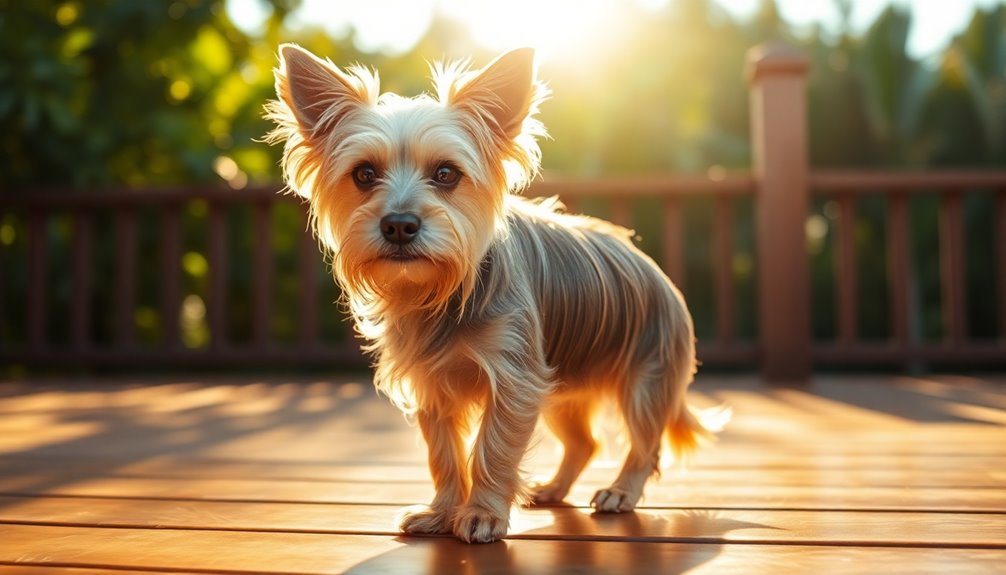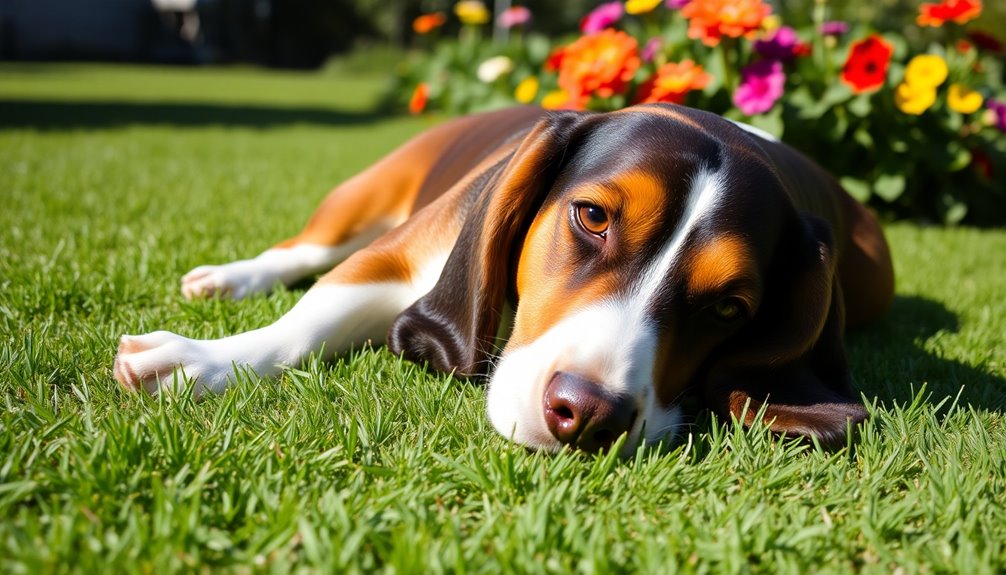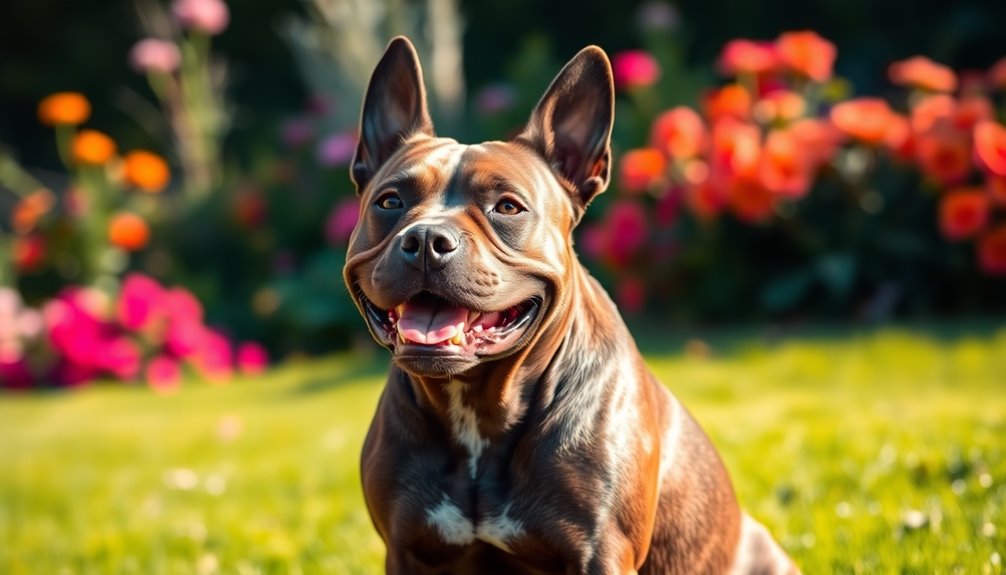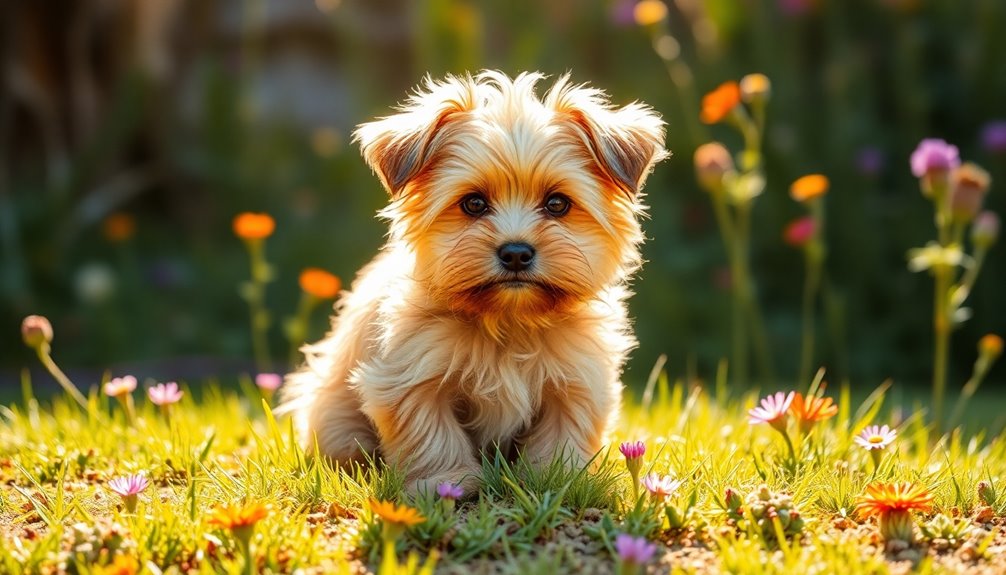The Silky Terrier is truly an elegant and spirited companion, perfect for those seeking a lively pet. Standing 9 to 10 inches tall, these dogs boast a unique blue and tan coat that requires regular grooming. Their playful personality makes them engaging, but they need daily exercise of about 30 to 45 minutes. While they're alert and will bark to protect you, early socialization is key to fostering good behavior. With a lifespan of 12 to 15 years, commitment to their care is essential. Stick around, and you'll discover even more about their charm and care requirements!
Key Takeaways
- Silky Terriers are small, elegant dogs standing 9 to 10 inches tall with a long, silky blue and tan coat.
- They possess a playful and spirited personality, requiring regular exercise and mental stimulation to thrive.
- Early socialization is essential to promote adaptability and prevent wariness or aggression toward strangers.
- Regular grooming, including brushing and trimming, is crucial to maintain their unique coat and overall appearance.
- Silky Terriers can adapt well to apartment living if their daily exercise needs are met, thriving on walks and interactive play.
Introduction

The Silky Terrier is an adorable companion known for its playful nature and elegant appearance. Standing at just 9 to 10 inches tall and weighing about 10 pounds, these small dogs are slightly longer than they're tall, giving them a unique silhouette. With a delicate bone structure and strong thighs, they exude both charm and strength.
Their stunning coat is long, flat, and silky, typically displaying a beautiful blue and tan color. However, this luxurious fur requires high maintenance; you'll need to brush them at least twice a week and bathe them every 1 to 2 weeks to keep it in top condition. Regular grooming is essential to prevent tangling and matting, so be prepared to invest some time and effort. Additionally, they have a lifespan of typically 13-15 years, making them a long-term commitment for any owner.
Silky Terriers are energetic little bundles of joy, needing 20 to 40 minutes of daily exercise. Their playful and mischievous personalities make them delightful companions, though they can be a bit tough and may display aggression toward other dogs.
With a friendly disposition towards strangers and a knack for being great watchdogs, they're perfect for anyone who appreciates a spirited, yet elegant, companion.
History and Origin
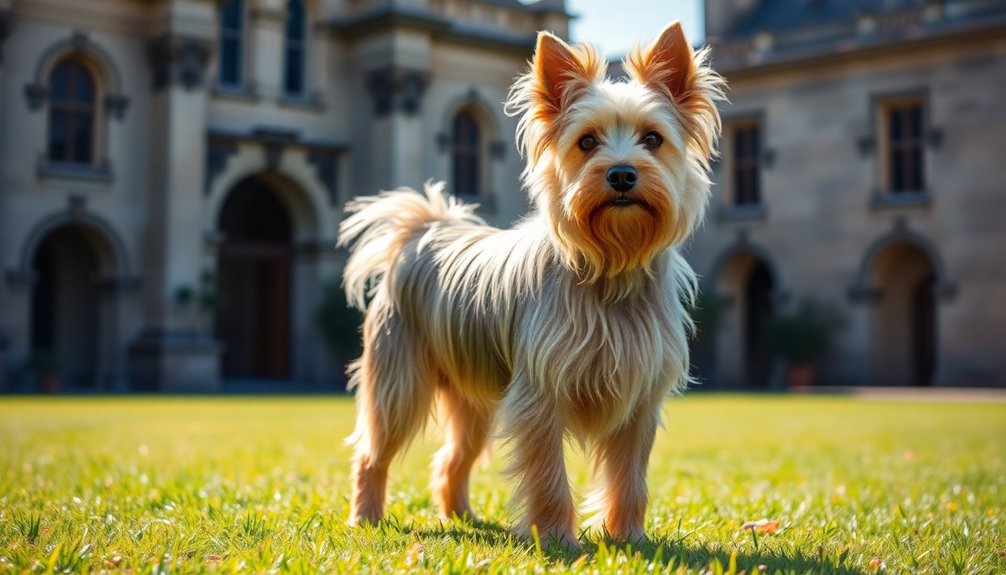
The Silky Terrier originated in Australia during the late 19th and early 20th centuries, crafted from various English terrier breeds. These little dogs were initially bred for rat-catching and pest control, showcasing their agility and tenacity. As you explore their history, you'll discover how their lineage shaped the affectionate companions we know today. The breed was officially recognized as the Australian Silky Terrier in June 1956, marking a significant milestone in its development.
Where and when the breed originated
Where did the Silky Terrier come from? This delightful breed originated in Australia during the late 19th century, thanks to English immigrants who brought small terrier dogs with them. They aimed to create a new breed by cross-breeding various terriers, including the Skye, Black and Tan, and the Yorkshire Terrier, among others. Regions like Victoria, New South Wales, and Tasmania played significant roles in this breeding program, particularly in urban and rural areas.
The initial cross-breeding began in the early 1800s, and by 1872, the Broken Coated Terrier made its debut at the Royal Melbourne Show. Just a few years later, in 1875, the Silky Coated Toy Terrier was exhibited in Tasmania. The breed was officially standardized as the Australian Silky Terrier in 1959, marking a significant milestone in its history.
The breed continued to develop and refine into the early 20th century, leading to its formal recognition. In 1906, the first Silky Terrier Club was established in New South Wales, laying the groundwork for future recognition.
Rat-Catching and Pest Control
During the Industrial Revolution in England, rat-catching breeds became essential for controlling pest populations in factories and mills. These dogs played a crucial role in mitigating health risks and preventing damage to goods stored in these facilities.
The practice of using ratting dogs dates back to events like the 1825 record set by Billy, a bull-and-terrier dog known for his impressive rat-catching skills. Even during World War I, these dogs were employed to manage rat populations in trenches.
While Silky Terriers aren't typically recognized for their rat-catching prowess, their speed and strength make them capable of overpowering rodents. Breeds like Jack Russell Terriers and Cairn Terriers excel in navigating tight spaces, while Miniature Schnauzers are adept at chasing through underbrush. German Hunting Terriers work effectively in packs, showcasing their energetic nature and versatility in hunting roles.
In modern times, groups like the Ryders Alley Trencher-fed Society (R.A.T.S.) in New York City continue the tradition of using dogs for pest control. As traditional methods become less effective, the demand for rat-catching dogs is increasing, highlighting their ongoing value in various environments.
Physical Characteristics
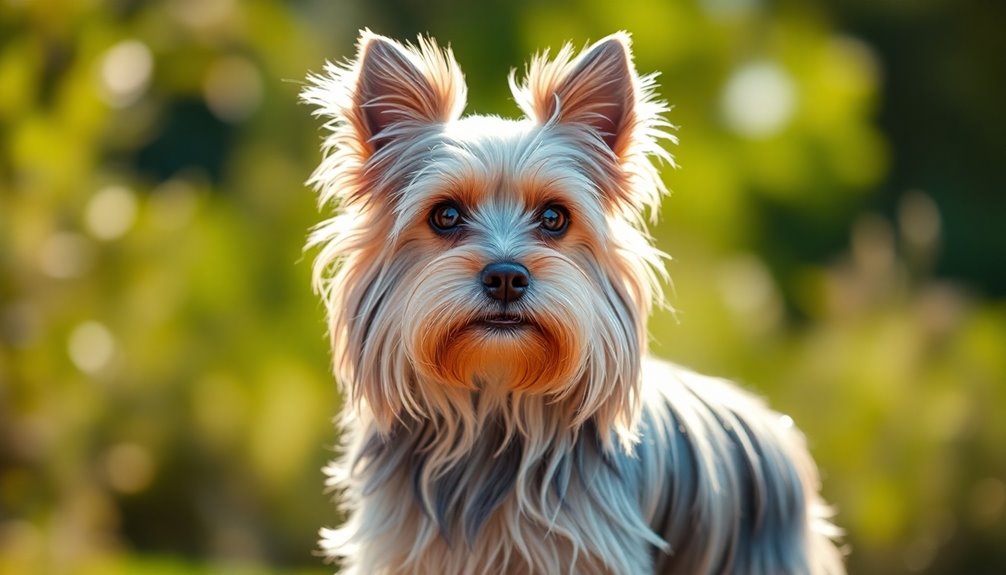
When you look at a Silky Terrier, you'll notice their petite size, standing about 9 to 10 inches tall and weighing between 8 to 11 pounds. Their long, glossy coat, often in blue and tan or grey and white, adds to their charm, but it does require regular grooming. Plus, don't forget those feathered legs and tail that give them an elegant appearance! These dogs are known for their lively and affectionate temperament, making them wonderful companions for families.
Size, weight, and coat details
The Silky Terrier is a compact and lightweight breed, typically standing between 9 and 10 inches tall and weighing around 8 to 11 pounds. These dogs have a body length ranging from 16 to 22 inches, making them a perfect fit for those looking for a small yet spirited companion.
Both male and female Silky Terriers generally weigh between 8 and 10 pounds, and they reach their adult weight in about 9 months.
Their coat is one of their standout features, characterized by long, silky, and fine hair that measures about 5 to 6 inches in length. The primary colors are blue and tan or black and tan, with their topknot often being lighter than the tan or red points. Puppies are born black and develop their adult coloring as they grow.
Grooming is essential for maintaining their luxurious coat, as it can easily become tangled or matted. Regular brushing is necessary to keep their fur flat, fine, and glossy. Additionally, the coat is prone to tangles, which is why daily grooming is highly recommended to prevent matting.
While they're considered hypoallergenic, they still require consistent care to look their best.
Feathered Legs and Tail
In addition to their stunning coat, Silky Terriers feature distinct feathering on their legs and tail that contributes to their overall elegance. The legs are characterized by a clean appearance, with hair only extending up to the knees and hocks. Below this point, the hair is kept short, allowing the refined, round bone structure of the forelegs to show through. The hair on the forelegs displays a rich golden tan, gradually lighter at the tips, enhancing their graceful look.
When it comes to the tail, it should be free from long feathering as well. Whether docked or undocked, the tail is set high and carried erect, creating a balanced silhouette. The tail's length complements the overall form of the dog, emphasizing its compact body and cat-like feet. This breed's moderate head length also contributes significantly to its elegant profile, enhancing its overall appeal.
To maintain this elegant appearance, you'll need to groom your Silky Terrier regularly. This routine helps prevent tangles and keeps the coat silky smooth.
Ensure the hair on the face and ears is trimmed to maintain cleanliness, while the fine 'top-knot' should be styled to avoid obstructing their vision, completing the refined look of this spirited companion.
Temperament and Personality
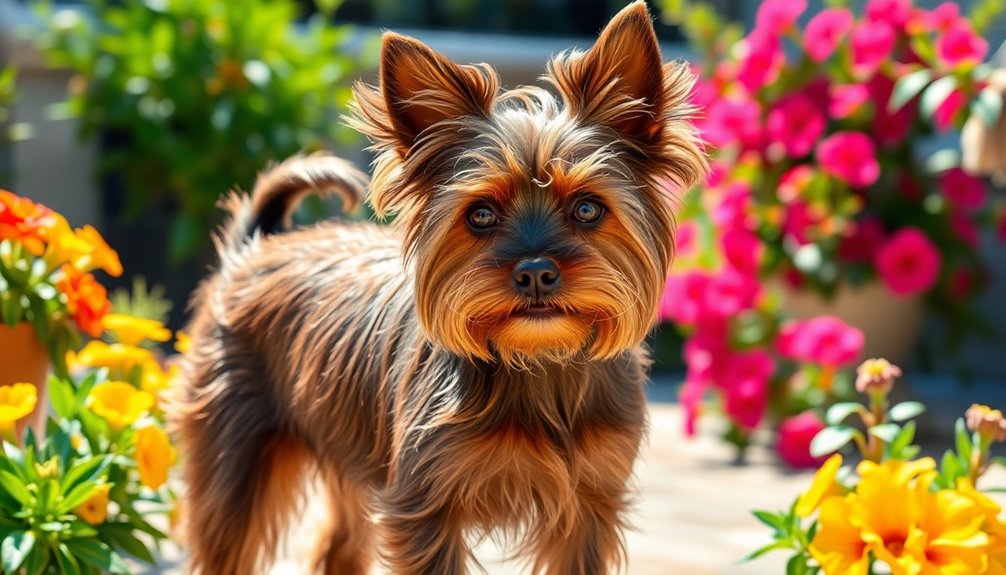
When you think about a Silky Terrier, picture a playful and spirited companion that brings joy to your home. These dogs thrive in family settings and can adapt well to individuals or households with other pets, though early socialization is key. Their energetic nature and affectionate demeanor make them a delightful addition to any family. To maintain their high-energy disposition, they require ample mental and physical stimulation.
Playful and Spirited Demeanor
Despite their small size, Silky Terriers burst with a playful and spirited demeanor that makes them captivating companions. These energetic little dogs thrive on regular exercise and mental stimulation, so you'll want to keep them engaged. They love playing games like fetch and are particularly fond of interactive activities that challenge their minds. If you've got an agility course or flyball setup, your Silky will be in heaven, happily burning off their excess energy.
Their spirited nature also means they're highly alert and can be quite feisty. They'll bark at unknown stimuli, keeping you informed of any potential intruders. Silky Terriers are quick and inquisitive, always eager to explore their surroundings. However, they need proper socialization to prevent wariness or aggression toward strangers. Regular grooming is also essential to maintain their coat health, as daily brushing helps to prevent matting and keeps them looking their best.
Intelligent and trainable, they respond well to positive reinforcement methods, though they can be a bit stubborn at times. Early training and socialization are essential to help manage their behavior.
In return for your efforts, you'll have a loyal, affectionate companion who loves to snuggle after a fun-filled play session. Just remember, keeping your Silky engaged is key to a happy, well-adjusted pet.
Suitability for families, individuals, or other pets
Silky Terriers make fantastic companions for both families and individuals due to their affectionate nature and strong desire for human connection. They bond closely with family members, thriving in active households where they receive plenty of attention. Their excellent family pets nature makes them particularly suitable for households with children.
While they're generally good with older children, supervision is essential when they interact with younger kids to prevent potential snapping. Early socialization helps improve these interactions.
For individuals, Silky Terriers require owners who can devote time and attention daily. They're known for following their owners closely, making them ideal for those who appreciate companionship. Their adaptability allows them to thrive in various living environments, including apartments, but they still need regular exercise and mental stimulation.
When it comes to other pets, Silky Terriers can exhibit dominant or territorial behavior, which may lead to aggression, particularly with other dogs. They often do best as the only pet in the home.
To foster positive relationships with other animals, early socialization and consistent training are critical. If you're prepared for their energetic and inquisitive nature, a Silky Terrier can be a delightful addition to your family or lifestyle.
Health and Lifespan

When it comes to your Silky Terrier's health and lifespan, you'll want to be aware of their typical lifespan of 11-14 years and the common health concerns they face. Keeping an eye on genetic predispositions can help you catch issues early. One notable concern is progressive retinal atrophy, which can lead to total blindness if not detected early.
Typical lifespan of the breed
The typical lifespan of a Silky Terrier ranges from 12 to 15 years, reflecting its small size and overall health. Your dog's lifespan can vary based on several factors, including diet and exercise. Providing high-quality dog food tailored to their size is crucial for maintaining their well-being. Regular moderate playtime will help keep your Silky active and healthy.
Routine grooming, such as regular brushing and monthly baths, not only keeps their long, silky coat in good condition but also promotes bonding time with you. Regular veterinary check-ups are essential, so don't skip those routine blood tests and health exams. Additionally, being aware of potential health issues such as collapsing trachea can help you take preventive measures. It is important to note that regular veterinary check-ups can aid in the early detection of health issues, ensuring timely intervention.
Keeping a structured environment with plenty of social interaction will contribute positively to their lifespan. Additionally, early training for obedience and social settings is vital. It helps them thrive in a family environment, ensuring they remain a happy, energetic companion.
Monitoring for any signs of potential health issues can also extend their time with you. Overall, by focusing on proper care, nutrition, and preventive health measures, you can help your Silky Terrier live a long, fulfilling life by your side.
Common health concerns or genetic predispositions
Many Silky Terrier owners may not be fully aware of the common health concerns and genetic predispositions that can affect their furry companions. One significant issue is diabetes mellitus, where your dog can't regulate blood sugar levels, leading to increased eating, drinking, and urination.
Hypothyroidism and Cushing's disease are other metabolic disorders that can cause weight gain and changes in behavior.
Orthopedic problems, such as Legg-Calve-Perthes disease and patellar luxation, can occur, resulting in pain and lameness. Regular veterinary visits can help catch these issues early.
Neurological disorders like epilepsy and progressive retinal atrophy can also affect Silkys, leading to seizures and gradual blindness.
Dental disease is common, so maintaining your dog's oral hygiene is crucial to prevent tartar buildup and infections.
Furthermore, conditions like color dilution alopecia and pyometra pose additional health risks. For male Silkys, cryptorchidism can increase the risk of cancer. Additionally, being aware of the breed's average lifespan can motivate owners to prioritize proactive health care.
Regular blood tests and check-ups can help detect these health concerns early, ensuring your beloved companion remains healthy and happy.
Tips for maintaining health and wellness
Regularly maintaining your Silky Terrier's health and wellness is essential for a long, happy life. With an average lifespan of 12 to 15 years, proper care can help your furry friend live even longer. Some individuals may exceed this range, living 3-4 years longer with the right care.
Start with a balanced diet; high-quality dog food formulated for small breeds is crucial. Make sure to avoid overfeeding and consult your veterinarian for dietary recommendations tailored to your dog's life stage.
Daily exercise is another key component. Aim for at least one hour of physical activity, including short walks twice a day. Access to large, open spaces will keep your Silky Terrier active and prevent behavioral issues.
Don't overlook grooming and hygiene. Brush your dog's coat at least twice a week to prevent matting and use a fine-toothed comb for tangles. Regular baths every four to six weeks, along with daily teeth brushing, will help prevent dental disease.
Lastly, schedule regular health checks with your vet. These visits are critical for catching any potential issues early and ensuring your Silky Terrier enjoys a vibrant, healthy life.
Care Requirements
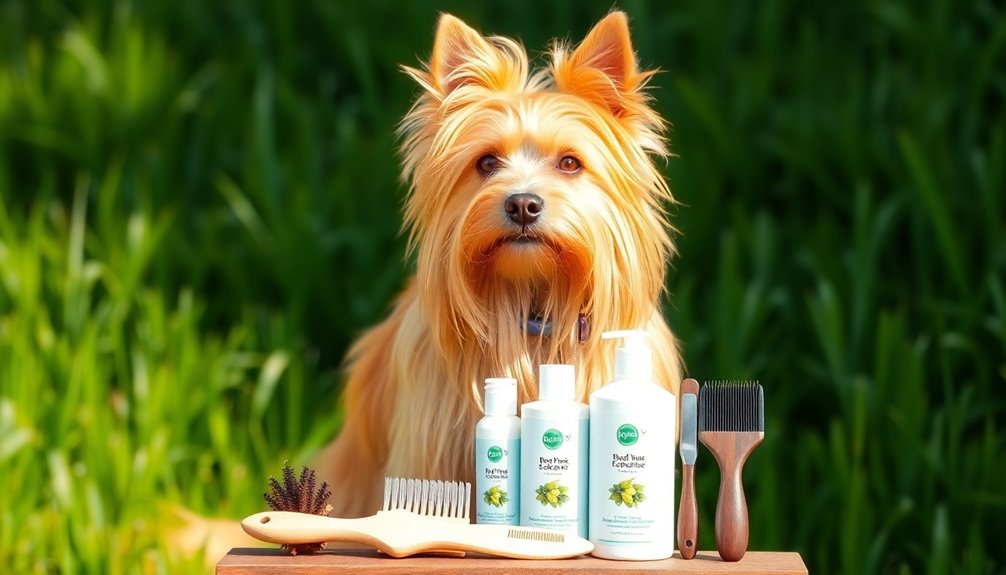
Caring for your Silky Terrier involves regular brushing to keep their coat healthy and tangle-free. You'll also need to provide them with plenty of exercise to manage their energy levels and keep them mentally stimulated. Additionally, pay attention to their diet to ensure they're getting the right nutrients for optimal health. Regular bathing and brushing are essential to maintain their single-layer coat, which resembles human hair, and requires cleanliness for growth.
Regular Brushing Required
To keep your Silky Terrier's coat in top condition, brushing at least twice a week is essential. Regular brushing not only prevents matting but also helps maintain that fine, silky texture. A full brush-out twice a week is especially important for young dogs to keep their coats looking their best.
When brushing, use a pin brush or a slicker brush to effectively remove loose fur. A soft-bristle brush can also work well. Always mist the coat lightly with a hydrating spray before you start; brushing a dry coat can lead to tangling.
Brush in a downward motion to avoid creating knots, and follow up with a metal comb to check for any tangles that might've been missed. Establishing a grooming routine not only enhances your dog's appearance but also builds comfort during grooming sessions.
Neglecting this grooming routine can lead to serious consequences, such as matting and discomfort for your dog. Dirty hair is prone to breakage, resulting in split ends and a loss of that beautiful shine.
Exercise requirements and energy levels
Maintaining your Silky Terrier's coat is just one aspect of their overall well-being; exercise plays a vital role in keeping them happy and healthy. You should provide your Silky with 30 to 45 minutes of exercise each day, which can include daily walks, games of fetch, and interactive play.
For puppies, keep their sessions shorter—around 5 to 10 minutes—to protect their developing bodies. By the time they reach about 12 months, they'll be ready for full adult exercise levels, but always consult your vet for personalized advice.
Silky Terriers have moderate energy levels, so regular exercise is essential to keep them mentally and physically stimulated. High spirits and alertness call for consistent activity, but be cautious about overheating; avoid exercising during the hottest parts of the day. Additionally, these dogs are known for their lively and friendly nature, which makes them great companions during outdoor activities.
If you live in an apartment or a home without a yard, don't worry! Regular walks and playtime can easily meet their needs. Just ensure you have a securely fenced area for safe outdoor play to avoid escape attempts.
Engaging them in dog sports like flyball or agility can also provide the mental challenge they crave.
Feeding tips and diet recommendations
When it comes to keeping your Silky Terrier healthy, a balanced diet is crucial. Focus on high-quality protein sources like beef, chicken, turkey, lamb, duck, eggs, and fish. Your pup will also benefit from essential fatty acids and omegas for energy and overall health. This breed has a tendency to gain weight, so keeping an eye on their portion control is important.
Incorporate small amounts of carbohydrates from vegetables, herbs, and berries to provide fiber and antioxidants. Always ensure access to fresh water and consider high-moisture foods to keep your dog hydrated.
Feed your Silky Terrier small, measured meals throughout the day to prevent overeating. Puppies should eat 3-4 meals, about ⅛ cup each, while adults typically need ½ to ¾ cup daily, split into two meals. Transition to adult food at around one year of age, and always consult your vet for personalized recommendations.
Opt for high-quality dog food specifically formulated for small breeds and ensure it meets AAFCO standards. Raw food diets may prevent common health issues, and low-fat options can help less active or overweight dogs.
Treats should only make up 10% of their diet, and consider omega-3 and joint supplements if needed, after consulting your veterinarian.
Training and Socialization
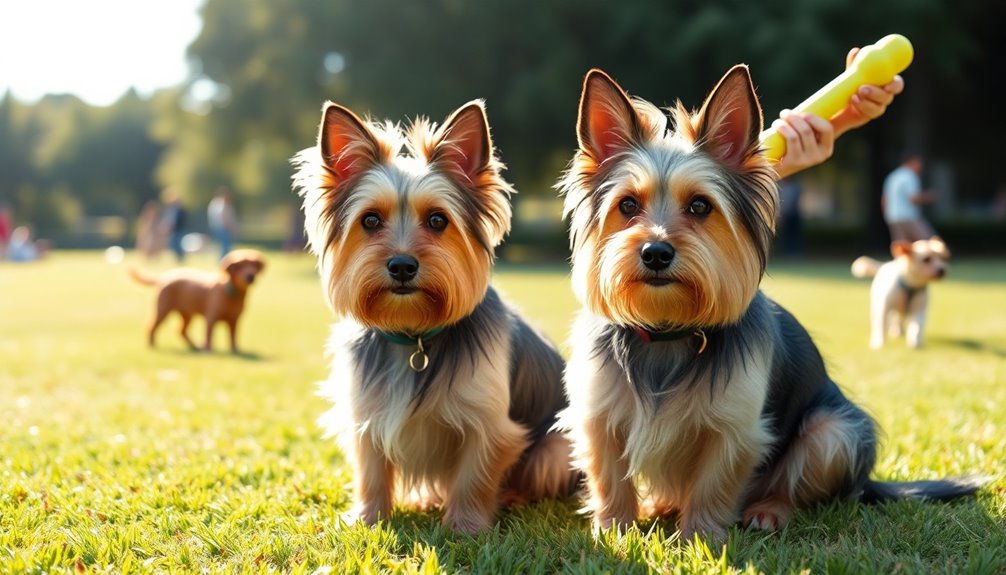
When training your Silky Terrier, you'll find they're moderately responsive to commands, so patience is key. Introduce them slowly to new environments to help build their confidence and reduce the risk of separation anxiety, especially in puppies. Additionally, crate training can be a beneficial method to provide your Silky Terrier with a sense of security while aiding in house training.
Moderately Responsive to Commands
Although Silky Terriers are moderately responsive to commands, their training can be both enjoyable and rewarding. You'll find that these intelligent little dogs respond well to gentle, reward-based training sessions. Using positive reinforcement techniques, like verbal praise or tasty treats, is highly effective in shaping their behavior.
Consistency and patience are crucial; remember, they thrive on loving attention from you. Early socialization is key to ensuring they integrate well with different environments and people. Regular outings to parks and training classes can significantly enhance their adaptability and confidence.
To help your Silky master basic commands, start with simple ones and gradually introduce more complex tasks. While they're quick learners, they may need extra time for advanced commands. Avoid punishment or yelling, as this can lead to stubbornness or fear, hindering their progress. Instead, focus on reinforcing good behavior with high-value rewards.
Early training and socialization are essential, ensuring your Silky integrates well into family life. Consider enrolling in obedience classes, especially puppy classes, to expose them to various sights and sounds.
Regular mental and physical exercise is vital for their health and happiness. By employing gentle training tools, like clickers or food rewards, you'll cultivate a well-behaved companion who's eager to please you.
Introduce Slowly to New Environments
To help your Silky Terrier thrive, introducing them slowly to new environments is vital for their socialization and overall well-being. During the critical socialization period from 3 to 16 weeks, your puppy is particularly vulnerable and impressionable. This is the perfect time to expose them to various sights, sounds, and surfaces. Positive experiences in new settings can prevent fearful or reactive behaviors later on.
Start with safe locations like parks or parking lots, and consider car rides to familiarize them with different environments. Use treats and praise to reinforce positive interactions, ensuring your puppy associates new experiences with reward. Enroll them in socialization classes or puppy preschool before 16 weeks to enhance their comfort around people, children, and other dogs.
Given their high energy levels, Silky Terriers benefit from regular outings that allow them to play and explore. Monitor your puppy's reactions closely; avoid forcing them into overwhelming situations that could create negative impressions. Instead, let them explore at their own pace.
Consistent and positive exposure now can significantly minimize barking and aggression issues in the future. By laying this foundation early, you'll help cultivate a confident and well-adjusted Silky Terrier that's ready to embrace the world.
Separation Anxiety in Puppies
Separation anxiety in puppies can be a challenging issue, especially if they haven't been properly socialized or trained from an early age.
To help your Silky Terrier, start with gradual desensitization. Leave your puppy alone for short periods, gradually increasing the time as they become more comfortable. Keep training sessions to just 5-10 minutes to avoid overwhelming them.
Establish a consistent routine that includes alone time, which normalizes separations. Use positive reinforcement—reward calm behavior with treats. Create a safe, comfortable space for your puppy, filled with interactive toys to keep them occupied. Playing calming music can also help create a soothing atmosphere. Balancing playtime with independent time is essential for developing their autonomy and confidence.
When you leave or return home, do so without fuss to prevent your puppy from associating departures with anxiety. Vary your leaving routine to keep them on their toes.
Ensure your puppy is tired before you go, encouraging them to rest rather than stress. Always monitor your puppy for signs of stress, responding calmly.
Avoid using corrections; instead, focus on rewarding good behavior. If anxiety persists, consider seeking professional help to address serious cases effectively.
Ideal Living Environment
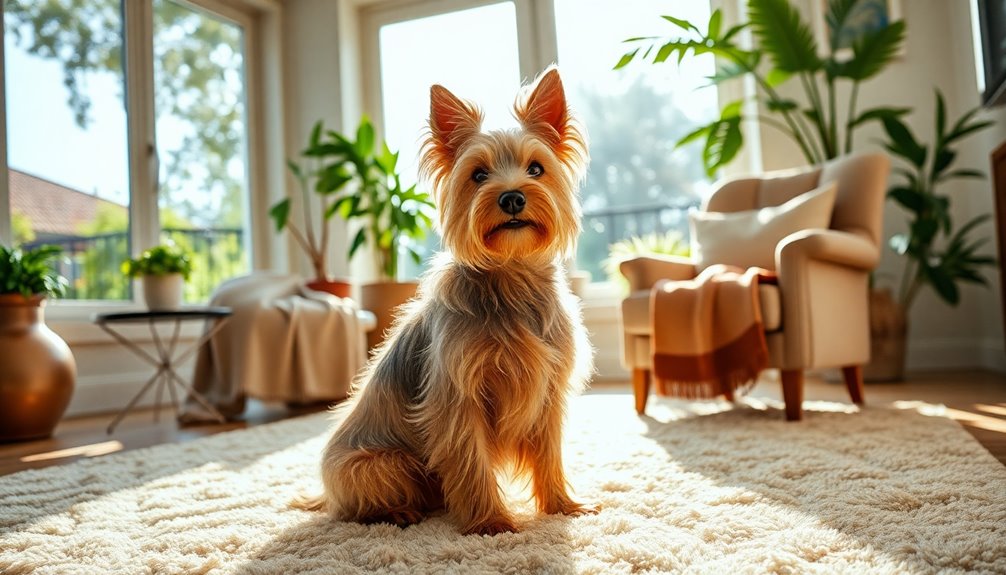
If you live in an urban apartment, a Silky Terrier can thrive there as long as you meet their exercise needs. They tolerate humidity well, making them suitable for various climates, but you'll need to ensure they've a secure outdoor space to explore safely. Regular walks and playtime will keep them happy and prevent any behavioral issues. Additionally, providing at least 1 hour of daily exercise is crucial for their overall happiness and well-being.
Urban Apartment Living
Living in a cozy urban apartment can be a perfect match for a Silky Terrier, thanks to their small size and affectionate nature. These spirited companions thrive indoors and love to follow you around, making them an ideal fit for your urban lifestyle. With the right care, they can adapt beautifully to apartment living.
To keep your Silky happy and healthy, ensure they get 30 to 60 minutes of exercise daily. Short walks and indoor playtime work wonders for their activity needs. Regular physical and mental stimulation is crucial to prevent boredom, so consider engaging toys or training sessions to keep their minds sharp. Additionally, smaller breeds generally adapt better to confined spaces, making them well-suited for apartment life.
While they may alert you to perceived threats with their barking, early training and socialization can help minimize excessive noise. Positive reinforcement techniques are effective in curbing unwanted barking.
Just remember, your Silky doesn't like to be alone for long periods, so plan your schedule accordingly.
With a little effort and attention, your Silky Terrier can thrive in an urban apartment, bringing joy and companionship into your life while adapting to the bustling city environment.
Humidity Tolerance Levels
For a Silky Terrier, maintaining optimal humidity levels is crucial to their overall health and comfort. They thrive in environments with low to moderate humidity, as high humidity can lead to skin issues like yeast infections. You'll want to check their skin regularly, especially in humid climates, for any signs of greasiness, odor, or thickening. Keeping their coat clean and dry is essential, and you might find that more frequent grooming is necessary to prevent matting. Silky Terriers can tolerate temperatures between 60ºF and 90ºF, but you should avoid exposing them to extremes for long periods. If humidity levels rise, consider using air conditioning to keep them cool. Additionally, small dogs like Silky Terriers require careful monitoring during extreme temperature conditions to ensure their well-being. Remember, they need at least one to two hours of daily exercise, which can be adjusted to suit the weather. Always keep them on a leash during outdoor activities to ensure their safety.
Unique Blue and Tan Coat

Your Silky Terrier's unique blue and tan coat not only stands out but also requires distinctive grooming to keep it looking its best. Inspired by Toto from "The Wizard of Oz," this breed's stylish appearance needs regular maintenance to prevent tangles and mats. Understanding these grooming needs will help you appreciate the beauty and character of your furry companion. Additionally, the breed's distinctive coloration sets it apart from many others, adding to its charm and appeal.
Distinctive Grooming Needs Required
With its unique blue and tan coat, the Silky Terrier demands special grooming attention to keep it looking its best. You should brush your Silky at least twice a week, or daily if they've a longer coat. Start brushing from the head and work your way down to the tail using a slicker brush to tackle tangles and mats. For stubborn knots, a leave-in conditioner can help prevent breakage.
After brushing, it's essential to trim the coat every four to six weeks to maintain its neat appearance and reduce shedding. Combing through the fur before trimming can simplify the grooming process.
When bathing your Silky, do so every 1 to 2 weeks using warm water and a dog-specific shampoo. Remember to apply conditioner to lock in moisture and keep tangles at bay. Rinse thoroughly, and finish with a cool water rinse to ensure all product is removed.
Regularly check their nails every four to six weeks, and inspect their ears weekly for wax buildup. Don't forget to brush their teeth weekly to maintain dental hygiene.
With consistent grooming, your Silky won't only look stunning but will also stay healthy and happy.
Toto From "The Wizard of Oz
Toto, the beloved companion of Dorothy in *The Wizard of Oz*, stands out not only for his loyalty but also for his distinctive appearance. Often depicted as a small black dog with long silky hair, Toto's character is thought to be a Cairn Terrier, although some argue he resembles a Yorkshire Terrier. His unique blue and tan coat adds to his charm, making him unforgettable in the hearts of fans. Additionally, Toto's playful nature and vibrant personality make him a memorable character among canine companions.
Throughout the story, Toto plays a crucial role in driving the plot. He brings joy to Dorothy's life, especially amid the bleakness of Kansas. His protective nature shines through as he stands by her side during their adventures in Oz. From leading them into the whirlwind that transports them to the magical land to revealing the Wizard's true nature, Toto's actions are pivotal. His actions function as a catalyst for key events, shaping the direction of Dorothy's journey.
Despite changes in his appearance across various adaptations—such as his portrayal by the brindle Cairn Terrier named Terry in the famous 1939 film—Toto remains a symbol of loyalty and bravery.
Whether in novels, films, or TV shows, his spirit continues to resonate with audiences, reminding us of the bond between a dog and its owner.
Active Lifestyle Compatibility?
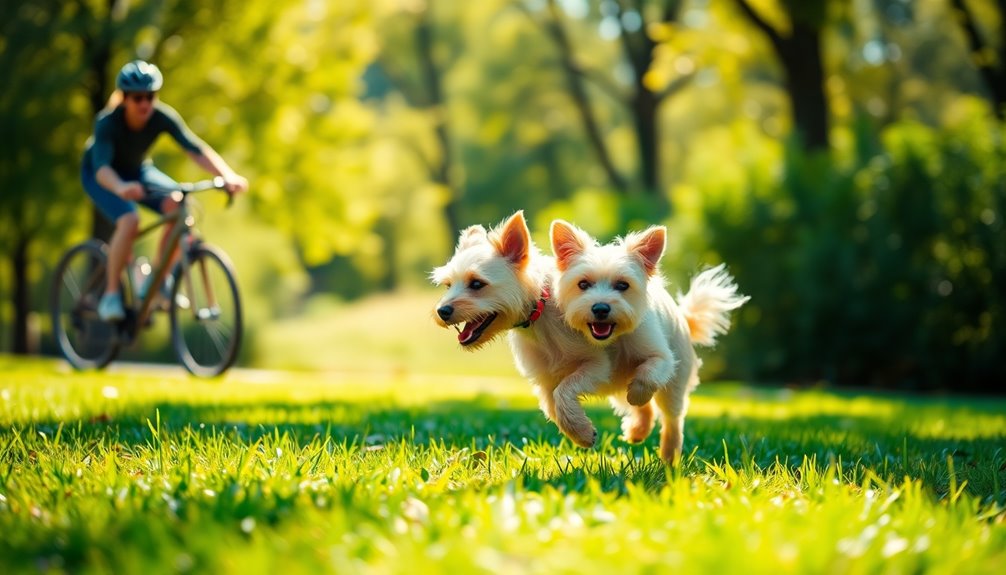
If you lead an active lifestyle, a Silky Terrier can be a fantastic companion for you. They thrive on daily walks and interactive play, making them perfect for those who enjoy staying engaged. Just remember that their grooming needs require commitment to keep their beautiful coat in top condition. Additionally, these dogs have a high-energy level, which means they will enjoy participating in various activities with you.
Ideal for Active Individuals
Active lifestyles thrive on companionship, and the Silky Terrier is the perfect partner for those who enjoy staying on the move. These spirited little dogs require 30-45 minutes of exercise each day, which means you'll need to be ready for daily walks, playtime, and interactive activities. They love engaging in games like fetch and tug of war, making playtime a fun way to bond. Regular exercise contributes to their overall health and keeps them mentally stimulated.
Silky Terriers adapt well to various living situations, be it urban or suburban, and they thrive in homes with older children or active individuals. If you work from home or can take them on errands, you'll find they excel in shared households where everyone contributes to their exercise routine.
They also enjoy playing in fenced yards and can manage indoor exercise on rainy days.
Training is key, so using positive reinforcement will help you shape their behavior, ensuring they remain a delightful part of your active life. With their energy and enthusiasm, Silky Terriers thrive in environments that keep them mentally and physically stimulated.
If you're looking for a spirited companion who matches your active lifestyle, the Silky Terrier might just be your ideal match.
Grooming Frequency and Commitment
Grooming your Silky Terrier is a commitment that complements your active lifestyle, requiring attention at least 2-3 times a week for brushing and baths every 1 to 2 weeks. Regular brushing helps prevent mats and tangles, keeping your pup's silky coat healthy and manageable. Use a pin or slicker brush, mist the coat lightly with a hydrating spray, and always brush in a downward motion. Start with the underside to tackle any hidden tangles effectively. Additionally, grooming frequency varies between show dogs and family pets, which can influence how you approach their care.
Bathing is equally important. Choose a dog shampoo and conditioner designed for silky coats, applying them in a downward motion to reduce tangling. Rinse thoroughly, ensuring all product is removed, and finish with a cool water rinse to lock in moisture.
After bathing, gently blot the coat with a towel to remove excess water, and use a warm air dryer while brushing to prevent matting. Avoid rubbing the coat, as this can cause tangles.
Finally, consider regular trims to maintain a neat appearance. By committing to this grooming routine, you'll ensure your Silky Terrier stays healthy, happy, and ready for all your adventures together!
Frequently Asked Questions
What Is the Average Weight of a Silky Terrier?
The average weight of a Silky Terrier is around 10 pounds.
Males typically weigh between 8 to 11 pounds, while females usually range from 8 to 10 pounds.
By the time they're about 9 months old, they reach their weight stability.
During puppyhood, expect them to gain about 10% of their body weight each week.
Do Silky Terriers Shed a Lot?
Silky Terriers don't shed a lot, so you won't have to worry about piles of fur around your home.
They've a single-layered coat, similar to human hair, which means they shed very lightly and produce minimal dander, making them relatively hypoallergenic.
However, regular grooming is important to prevent matting and keep their coat looking its best.
You'll need to brush them at least twice a week to maintain their beautiful appearance.
How Long Do Silky Terriers Typically Live?
Silky Terriers typically live between 12 to 15 years, with some reaching up to 17 years.
Your pet's lifespan can vary based on their overall health and the care you provide.
To help them live longer, focus on a balanced diet, regular exercise, and routine vet check-ups.
Keeping them at a healthy weight and providing mental stimulation through play and socialization are also key to ensuring a long, happy life.
Are Silky Terriers Good With Children?
Silky Terriers can be a mixed bag when it comes to children. They're affectionate and loyal, but their feisty nature mightn't mesh well with toddlers.
Young kids may unintentionally provoke them, leading to nipping. If you have older children, they might get along better, especially if the kids understand boundaries.
Just remember to supervise interactions and ensure your Silky gets enough mental and physical stimulation to keep them happy and well-behaved.
What Is the Grooming Frequency for a Silky Terrier?
For a silky terrier, you'll want to brush their coat a few times a week, ideally two times weekly for a full brush out.
Regular baths every 1 to 2 weeks help keep their coat clean. After bathing, gently dry them with a towel and use a warm air dryer while brushing.
Don't forget to check their ears, nails, and teeth regularly to ensure overall grooming and health are maintained.
Conclusion
In conclusion, the Silky Terrier makes a charming and lively companion for those who appreciate its elegance and spirited nature. With proper training and socialization, this breed thrives in an active lifestyle, bringing joy and vitality to your home. Whether you're exploring the outdoors or enjoying quiet moments together, the Silky's unique blue and tan coat and playful personality will brighten your days. If you're ready for a loyal friend, the Silky Terrier could be the perfect match!

